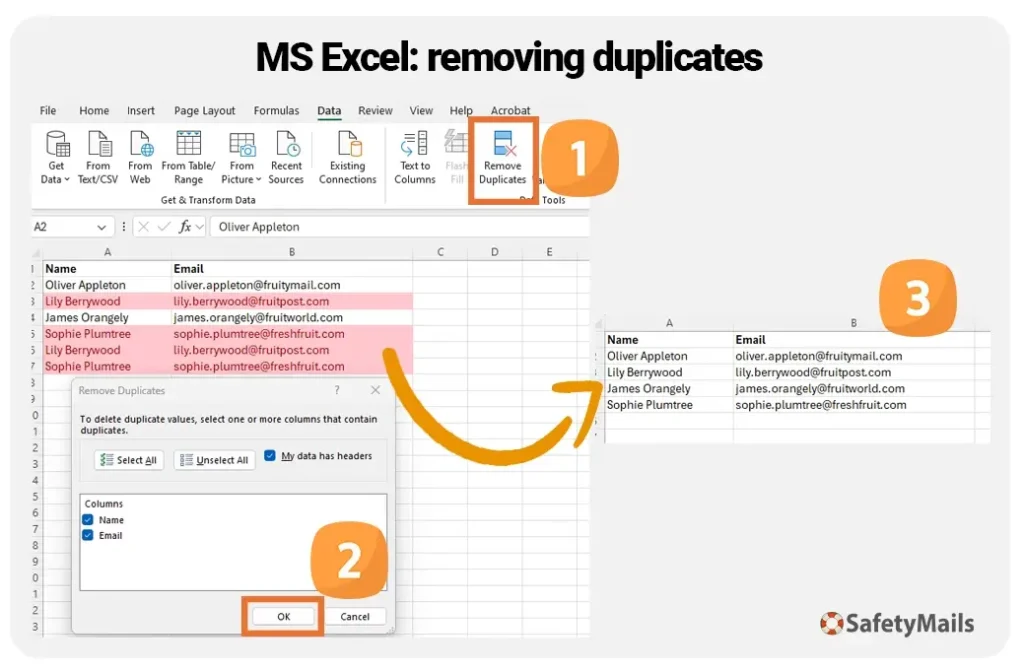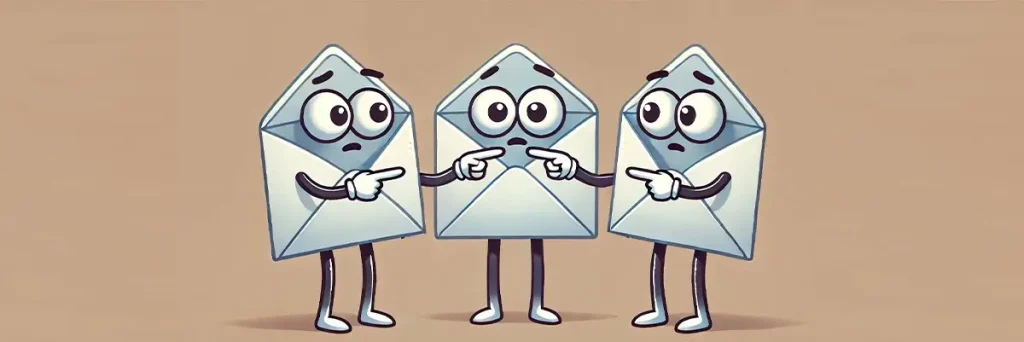Removing duplicate emails from lists, whether for verification or for use in campaigns, is important because it helps to improve email marketing’s reputation, deliverability, key metrics, conversion results and ROI, as well as avoiding spam complaints and unnecessary costs.
Email lists are the raw material for email marketing actions and therefore require a lot of care to maintain their quality, in order to have a positive impact on ROI and bring concrete results for companies.
Thus, among other things initiatives that need to be taken, removing duplicate emails is one of them.
Table of contents
What are duplicate emails?
Duplicate emails are email addresses that appear more than once in a contact list. Note that we don’t say “twice”, but more than once. And yes, there are email lists with records that appear dozens of times.
Although this may not seem like a problem at first, and may even be harmless, the fact is that duplicate emails can cause problems for email marketing campaigns, your reputation and your results.
Common causes of email duplication
Email records can be duplicated in contact lists for a variety of reasons, for example:
- Human error: when entering data manually, systems or spreadsheets may not have control mechanisms to prevent duplicate entries.
- Importing lists from different sources without filtering: When uploading and importing mailing lists from different sources, it is important that some key fields are taken into account to avoid duplicate data. As the e-mail address is unique, it is one of the fields for this purpose.
- Failure to integrate CRM and Marketing platforms: Another method that can fail is integration between platforms. Eventually, when entering or transferring data, records can be duplicated. Repeated registrations from landing pages are one of the most common examples.
As you can see, mistakes are not intentional. They occur due to minor faults or negligence during programming.

Consequences of not removing duplicate emails
Mailing lists that don’t have the proper treatment and removal of duplicate emails cause a lot of problems for the company and its email marketing actions:
Problems with e-mail marketing
Among the problems that lists with duplicate emails can cause are:
- Negative perception of the recipient: by receiving multiple identical messages, recipients can get a negative impression of your business, of a lack of organization and care. Eventually, this impression can become an annoyance.
- Increase in spam complaints: since receiving several identical messages can irritate recipients, they may trigger spam complaint mechanisms, damaging your reputation. What’s more, email providers recognize these multiple identical sends and can apply anti-spam filtering, blocking your messages.
- Problems with deliverability and openness metrics: As you suffer from spam blocks and complaints, your sender reputation drops. As a result, ISPs start to deliver more messages to the spam folder, which is a deliverability problem. As fewer messages are displayed in the inbox, recipient opening interactions are also reduced, damaging engagement and conversion results.
- Increased costs: Sending duplicate emails generates additional costs on email marketing platforms, especially on pay-per-volume tools.
Benefits of removing duplicate emails
As you might expect, the benefits brought by removing duplicate emails solve all the difficulties that could be encountered if this process were ignored.
- More efficient campaigns: With more organized contact lists, metrics such as deliverability, open rate, CTR (Click-through rate) and conversions tend to be much better.
- Cost savings: without duplicate emails, the size of databases stored in email marketing and CRM services is reduced, which can lead to savings.
- Better relationship: by avoiding sending unnecessary emails, you also avoid possible friction and wear and tear on your relationship with the recipients, helping to promote an image of organization.
- Protection of the sender’s reputation: removing duplicate emails prevents multiple identical messages from being sent, avoiding spam complaints and anti-spam blocks from email providers.
- Better compliance with regulations: by maintaining a clean mailing list free of duplicate records, there is better compliance with data protection laws.
Methods and tools for identifying and removing duplicate emails
You can use one or more methods, manual or automatic, to remove duplicate emails from your email contact lists. The important thing is to get rid of duplicate records.
Obviously, opting for automated solutions will not only save you time and effort, but will also be much more reliable.
The basics: removing duplicate records in MS Excel
Starting with the basics, if you don’t yet have an email marketing platform or a CRM and your contacts are all gathered in an Excel spreadsheet, no problem: you can remove duplicate records with just a few clicks. Take a look:

In your Microsoft Excel, select the data columns, click on the “Data” tab and then on the “Remove Duplicates” option. In the window that appears, select the column that has duplicate data and click “OK”. The result will then be displayed without the duplicate records. It’s as simple as that.
Specialized systems
You can use platforms that already have solutions for removing or preventing duplicate data. These are usually CRM or e-mail marketing systems.
These platforms have data organizing functionalities that will delete duplicate data or aggregate data into a single record.
However, we also recommend automated email verification tools such as SafetyMails. When you upload your mailing lists for verification, it not only removes invalid emails, spamtraps, temporary emails and more, it also removes duplicate email records. All automatically.
Best practices to avoid duplicate emails
On a day-to-day basis, try to adopt some measures to avoid duplicate data, especially email data.
- Standardization of data collection: make sure that landing pages, forms and registration systems are prepared to deal with duplicate data. Standardizing collection is also important, because it avoids similar data being entered in different ways or with errors, but related to the same record. Also define the data that cannot be repeated, such as e-mail. When a duplicate record is made, have it processed and used to feed existing records.
- Care when synchronizing data: When data is obtained from various sources, it is necessary to define which data cannot be duplicated and also what the systems or databases need to do when there are occurrences of this nature: ignore, delete or merge.
- Audits and periodic cleaning of lists: It’s important to plan periodic email cleaning and verification routines to remove invalid and harmful emails, as well as duplicate records.

Conclusion
Removing duplicate emails from your contact lists is important for optimizing your email marketing campaigns, protecting your reputation as a sender and avoiding unnecessary costs.
The presence of duplicates not only negatively impacts your deliverability and conversion metrics, but can also lead to spam complaints, damaging the sender’s reputation in the long term.
The adoption of specialized tools, good data collection and auditing practices allows your mailing list to remain efficient and accurate. Implementing these verification routines will bring direct results for the ROI of your campaigns.
FAQ
What are duplicate emails and why are they a problem?
Duplicate emails are email addresses that appear more than once in a contact list. Although they may seem harmless, they can distort email campaign metrics, increase operating costs and result in a bad experience for the recipient, who may end up complaining about spam. This damages your reputation and directly affects the deliverability of your messages.
What are the most common causes of email duplication?
Duplicate emails often arise from human error, such as manually entering data without duplicate control, or from the inadequate integration of different CRM and marketing systems, which do not properly synchronize data. Importing lists from different sources without proper filtering is also a recurring cause of duplicate records.
What are the consequences of keeping duplicate emails on a list?
Keeping duplicate emails can result in multiple negative consequences, including increased costs, as many email platforms charge for sending volume. In addition, duplication damages the sender’s reputation, as sending identical messages to the same recipient can result in spam reports and blocks from email providers, as well as damaging open and conversion rates.
How do I remove duplicate emails from a list?
Duplicate emails can be removed manually using tools such as Microsoft Excel or by using specialized email marketing and CRM platforms that have automated features to detect and eliminate duplicates. Email verification tools such as SafetyMails also offer an automated solution that identifies and removes duplicates, making the process fast and reliable.
What are the best practices to avoid duplicate emails in the future?
To avoid duplicate emails, standardize data collection on forms and landing pages, ensuring that the email field is unique. Also, be careful when synchronizing databases from different sources and carry out periodic audits of mailing lists to ensure that they are always clean, up-to-date and free of duplicates.



